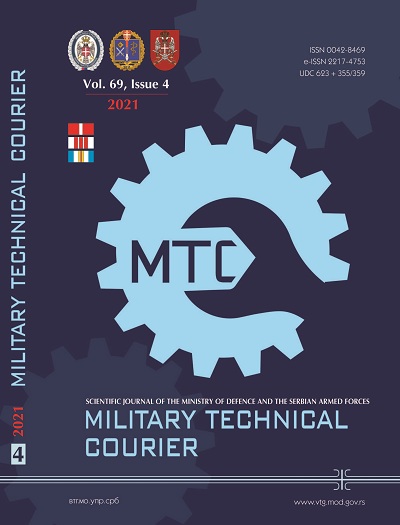Biometric standards and methods
Abstract
Introduction/purpose: Nowadays, user identification systems play a very important role in modern society. Complex security requirements have led experts to explore ways in which biometric data can be used to identify user identities. This paper presents an overview of biometric standards and methods which can be used to identify users in biometric systems, and therefore to protect information and communication systems.
Methods: This paper deals with the problem of standardization in the field of biometrics. The first part of the paper presents concrete examples of the most widely used biometric standards. The second part of the paper gives an overview of the most used biometric methods.
Results: The obtained results show that the development of biometric systems and biometric sensors contributes to better protection of identity from misuse, because biometric technologies have great potential for improving the security and accuracy of system operation. Biometric systems improve the security of users and also provide much greater precision in establishing identity.
Conclusion: The development of biometric standards should focus on their interconnectivity, as well as on increasing connectivity with other IT standards.
References
Al-Maadeed, S., Bourif, M., Bouridane, A. & Jiang, R. 2016. Low-quality facial biometric verification via dictionary-based random pooling. Pattern Recognition, 52, pp.238-248. Available at: https://doi.org/10.1016/j.patcog.2015.09.031.
Belcher, C. & Du, Y. 2008. A Selective Feature Information Approach for Iris Image-Quality Measure. IEEE Transactions on Information Forensics and Security, 3(3), pp.572-577. Available at: https://doi.org/10.1109/TIFS.2008.924606.
Bhardwaj, I., Londhe, N.D. & Kopparapu, S.K. 2017. A spoof resistant multibiometric system based on the physiological and behavioral characteristics of fingerprint. Pattern Recognition, 62, pp.214-224. Available at: https://doi.org/10.1016/j.patcog.2016.09.003.
Chen, Y., Atnafu, A.D., Schlattner, I., Weldtsadik, W.T., Roh, M.C., Kim, H.J., Lee, S.W., Blankertz, B. & Fazli, S. 2016. A High-Security EEG-Based Login System with RSVP Stimuli and Dry Electrodes. IEEE Transactions on Information Forensics and Security, 11(12), pp.2635-2647. Available at: https://doi.org/10.1109/TIFS.2016.2577551.
Chun, S.Y. 2016. Single pulse ECG-based small scale user authentication using guided filtering. In: International Conference on Biometrics (ICB), Halmstad, Sweden, pp.1-7, June 13-16. Available at: https://doi.org/10.1109/ICB.2016.7550065.
Jain, A., Hong, L. & Pankanti, S. 2000. Biometric identification. Communications of ACM, 43(2), pp.90-98. Available at: https://doi.org/10.1145/328236.328110.
Jain, A. K., Ross, A. & Prabhakar, S. 2004. An Introduction to Biometric Recognition. IEEE Transactions on Circuits and Systems for Video Technology, 14(1), pp.4-20. Available at: https://doi.org/10.1109/TCSVT.2003.818349.
Kumar, A. & Prathyusha, K.V. 2009. Personal Authentication Using Hand Vein Triangulation and Knuckle Shape. IEEE Transactions on Image Processing, 18(9), pp.2127-2136. Available at: https://doi.org/10.1109/TIP.2009.2023153.
Lalović, K. 2018. Patent overview: Device for fingerprint identity guarantee. Vojnotehnički glasnik/Military Technical Courier, 66(2), pp.366-379. Available at: https://doi.org/10.5937/vojtehg66-15868.
Lalović, K., Anđelić, S. & Tot, I. 2017. How to guarantee baby identity based on fingerprint biometry. In: The Ninth International Conference on Business Information Security (BISEC-2017), Belgrade, pp.1-4, October 18 [online]. Available at: http://bisec.rs/files/2017/16-k-lalovic-s-andjelic-i-tot-bisec-2017.pdf [Accessed: 20 February 2021].
Lalović, K., Maček, N., Milosavljević, M., Veinović, M., Franc, I., Lalović, J. & Tot, I. 2016a. Biometric Verification of Maternity and Identity Switch Prevention in Maternity Wards. Acta Polytechnica Hungarica, 13(5), pp.65-81. Available at: https://doi.org/10.12700/APH.13.5.2016.5.4.
Lalović, K., Milosavljević, M., Tot, I. & Maček, N. 2015. Device for Biometric Verification of Maternity. Serbian Journal of Electrical Engineering, 12(3), pp.293-302. Available at: https://doi.org/10.2298/SJEE1503293L.
Lalović, K., Nikolić, J., Tot, I. & Lalović, Ž. 2016b. Software algorithm of device for biometric identification of parenthood. In: The Eighth International Conference on Business Information Security (BISEC-2016), Belgrade, pp.66-71, October 15 [online]. Available at: https://www.metropolitan.ac.rs/files/2016/10/BISEC2016_Conference-Proceedings.pdf#page=67 [Accessed: 20 February 2021].
Lalović, K., Tot, I., Arsić, A. & Škarić, M. 2019. Security Information System, Based on Fingerprint Biometrics. Acta Polytechnica Hungarica, 16(5), pp.87-100. Available at: https://doi.org/10.12700/APH.16.5.2019.5.6.
Maček, N., Đorđević, B., Gavrilović, J. & Lalović, K. 2015. An Approach to Robust Biometric Key Generation System Design. Acta Polytechnica Hungarica, 12(8), pp.43-60. Available at: https://doi.org/10.12700/APH.12.8.2015.8.3.
Nakamura, T., Goverdovsky, V. & Mandic, D.P. 2017. In-ear EEG biometrics for feasible and readily collectable real-world person authentication. IEEE Transactions on Information Forensics and Security, 13(3), pp.648-661. Available at: https://doi.org/10.1109/TIFS.2017.2763124.
Odinaka, I., Lai, P-H., Kaplan, A.D., O’Sullivan, J.A., Sirevaag, E.J. & Rohrbaugh, J.W. 2012. ECG Biometric Recognition: A Comparative Analysis. IEEE Transactions on Information Forensics and Security, 7(6), pp.1812-1824. Available at: https://doi.org/10.1109/TIFS.2012.2215324.
Ortega-Garcia, J., Bigun, J., Reynolds, D. & Gonzalez-Rodriguez, J. 2004. Authentication gets personal with biometrics. IEEE Signal Processing Magazine, 21(2), pp.50-62. Available at: https://doi.org/10.1109/MSP.2004.1276113.
Prabhakar, S., Pankanti, S. & Jain, A.K. 2003. Biometric recognition: Security and privacy concerns. IEEE Security and Privacy, 1(2), pp.33-42. Available at: https://doi.org/10.1109/MSECP.2003.1193209.
Thevenot, D.R., Toth, K., Durst, R.A. & Wilson, G.S. 2001. Biosensors and Bioelectronics, 16(1-2), pp.121-131. Available at: https://doi.org/10.1016/S0956-5663(01)00115-4.
Tot, I., Trikoš, M., Bajčetić, J., Lalović, K. & Bogićević, D. 2021. Software Platform for Learning about Brain Wave Acquisition and Analysis. Acta Polytechnica Hungarica, 18(3), pp.147-162. Available at: https://doi.org/10.12700/APH.18.3.2021.3.8.
Unar, J.A., Seng, W.C. & Abbasi, A. 2014. A review of biometric technology along with trends and prospects. Pattern Recognition, 47(8), pp.2673-2688. Available at: https://doi.org/10.1016/j.patcog.2014.01.016.
Wang, J. & Wang, G. 2017. Quality-Specific Hand Vein Recognition System. IEEE Transactions on Information Forensics and Security, 12(11), pp.2599-2610. Available at: https://doi.org/10.1109/TIFS.2017.2713340.
Proposed Creative Commons Copyright Notices
Proposed Policy for Military Technical Courier (Journals That Offer Open Access)
Authors who publish with this journal agree to the following terms:
Authors retain copyright and grant the journal right of first publication with the work simultaneously licensed under a Creative Commons Attribution License that allows others to share the work with an acknowledgement of the work's authorship and initial publication in this journal.
- Authors are able to enter into separate, additional contractual arrangements for the non-exclusive distribution of the journal's published version of the work (e.g., post it to an institutional repository or publish it in a book), with an acknowledgement of its initial publication in this journal.
- Authors are permitted and encouraged to post their work online (e.g., in institutional repositories or on their website) prior to and during the submission process, as it can lead to productive exchanges, as well as earlier and greater citation of published work (See The Effect of Open Access).

